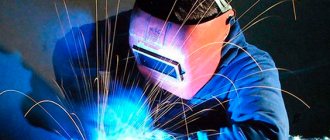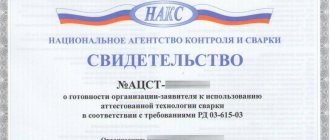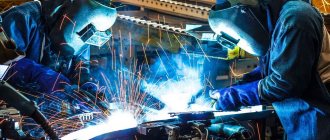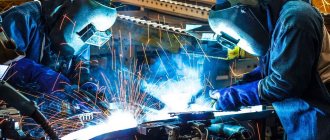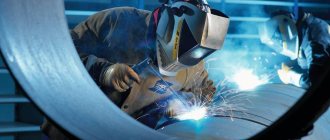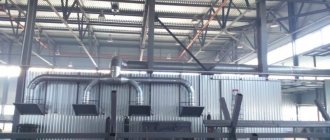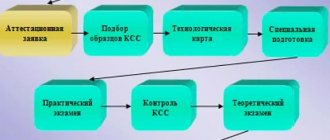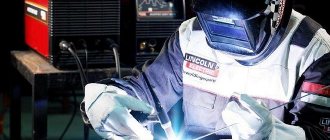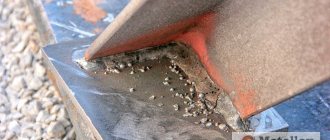Exam tickets for testing the knowledge of welding specialists level 2
We continue to publish materials necessary to test the knowledge of specialists in production. We remind you that all material is provided for self-testing of knowledge!
Tickets for the general exam to test the knowledge of welding specialists LEVEL II
TICKET No. 1
QUESTION 1
What features most fully reflect the essence of manual electric arc fusion welding (MAW)?
1. Melting of the metal rod, electrode coating and base metal and protection of the arc and metal of the weld pool with gas from melting of the electrode coating
2. Protection of the arc and weld pool with gas from melting the electrode coating
3. Melting of the base metal from the thermal effects of the electric arc, rod and electrode coating.
QUESTION 2
Which steel smelting method provides the highest quality metal?
1. Melting in a converter.
2. Melting in open hearth furnaces.
3. Melting in electric furnaces.
QUESTION 3
What is called semi-quiet steel?
1. Steel with silicon content up to 0.07 wt. percent and 1 wt. percent of manganese, not completely deoxidized during smelting.
2. Steel with a silicon content of more than 0.1 wt. percent, completely deoxidized during smelting.
3. Steel alloyed with molybdenum and tungsten.
QUESTION 4. Which of the structural components of steel has the greatest hardness?
1. Ferrite.
2. Perlite.
3. Cementite
QUESTION 5
What causes the appearance of hardening structures near the weld?
1. High carbon content in the base metal and high heat dissipation.
2. Slow cooling of the part.
3. Low welding speed.
QUESTION 6
What types of corrosion failure of welded joints exist?
1. Destruction from general corrosion, intergranular corrosion, stress corrosion cracking.
2. Destruction in the weld, heat-affected zone, along the fusion line.
3. Structural, general, local along the fusion line.
QUESTION 7
What is the most correct definition of a welding arc?
1. Electric arc discharge at the point where the circuit is broken.
2. Electric arc discharge in a partially ionized mixture of metal vapor, gas, electrode components, coatings, and fluxes.
3. Electric arc discharge in a mixture of atoms and air molecules.
QUESTION 8
What is the main purpose of a welding transformer?
1. Increasing the power taken from the network.
2. Reducing the voltage of the electrical network.
3. Reducing the frequency of the supply network.
QUESTION 9
Specify the cable cross-section for welding at currents from 100 to 200A?
1. Not less than 16 mm2.
2. Not less than 25 mm2.
3. Not less than 35 mm2
QUESTION 10
What should be the current value when arc welding in the ceiling position compared to the current value when welding in the lower position?
1. The current value when welding in the ceiling position should be less than when welding in the lower position.
2. The current value when welding in the ceiling position should be greater than when welding in the lower position.
3. The magnitude of the current does not depend on the welding position.
QUESTION 11
Indicate whether it is necessary to heat parts when welding temporary technological fasteners made of carbon, manganese and silicon-manganese steels?
1. Required if parts with a wall thickness that require heating during welding are being assembled.
2. Heating may not be performed for any thickness of the parts.
3. Required, but only at negative air temperatures.
QUESTION 12
For what class of steels are electrodes of types E-70, E-85,
E-100, E-125, E-150?
1. For welding heat-resistant steels.
2. For welding structural steels of increased and high strength.
3. For welding carbon and low-alloy structural steels.
QUESTION 13
Why is it not recommended to use calibrated tungsten electrodes for welding?
1. Expensive and scarce.
2. They have less durability compared to lanthanum and yttriated tungsten electrodes.
3. They have natural radioactivity.
QUESTION 14
In which area of the welding arc is the temperature highest?
1. In the cathode region.
2. In the anode region.
3. In the arc column.
QUESTION 15
What color is a helium storage tank painted?
1. Gray.
2. Blue.
3. Brown.
QUESTION 16
What current-voltage characteristics can power sources be used for mechanized welding in carbon dioxide?
1. With a falling current-voltage characteristic of the source.
2. With an increasing current-voltage characteristic of the source.
3. With a rigid or flat-sloping current-voltage characteristic of the source.
QUESTION 17
What requirements must be met for the calcination of flux before it is delivered to the production site for welding?
1. Flux must be calcined at a temperature of 300 - 400 0C for 1 hour.
2. Welding flux does not require additional preparation and can be used as factory supplied.
3. Flux must be calcined at a temperature of 100 - 150 0C for 1 hour.
QUESTION 18
What is the source of heat in electroslag welding?
1. Heat released in a bath of molten flux when current passes through it from the electrode to the product.
2. Heat generated in an electric arc between the electrode and the product protected by a layer of flux.
3. An electric arc between a layer of molten flux and the product.
QUESTION 19
What does the letter “E” and the numbers following it mean in the electrode markings?
1. Electrode brand and development number.
2. Manufacturer and coating number.
3. Type of electrode and guaranteed tensile strength of the metal deposited by them in kgf/mm2.
QUESTION 20
What should be the type and polarity of the current when welding joints made of carbon steels with calcium fluoride coated electrodes?
1. Alternating current.
2. Direct current of reverse polarity.
3.Alternating current or direct current of reverse polarity.
QUESTION 21
What is the power frequency alternating current source?
1. Transformer.
2. Rectifier
3. Battery
4. Transistor generator
QUESTION 22
Is it necessary to perform heat treatment of a welded joint made of dissimilar steels to eliminate residual stresses if the welding was carried out with austenitic electrodes and one of the steels is hardenable?
1. No.
2. Yes.
3. It is necessary if heating for welding was not carried out.
QUESTION 23
What types of control are accompanied by destruction of the welded joint?
1.Hydraulic tests, paint method.
2. Ultrasonic testing, radiographic.
3. Testing of the welded joint and deposited metal for static tension, impact bending, static bending, hardness, study of the microstructure of the joint. .
QUESTION 24
What is meant by heat resistance of a metal?
1. Ability to maintain strength at high temperatures.
2. Ability to resist carburization at high temperatures.
3. Ability to resist oxidation at high temperatures.
QUESTION 25
Specify the main features of “technological strength of metals during welding”?
1. The ability of the metal of welded joints to provide strength at the level of the base metal.
2. The ability of the metal of welded joints to provide service (operational) properties at the level of the base metal.
3. The ability of the metal of the welded joint to withstand the entire welding process without various types of damage (destruction).
QUESTION 26
What is the difference between flash butt welding and resistance butt welding?
1. High compression force of joined products.
2. Melting of the edges of the welded products before upsetting.
3. Compression and welding in the solid phase.
QUESTION 27
Should tacks that have unacceptable external defects (cracks, external pores, etc.) detected by visual inspection be removed?
1. It should.
2. Don't.
3.Only as directed by the welding supervisor.
QUESTION 28
What is the minimum size of a defect that can be detected by the naked eye?
1.0.01mm
2. 0.05 mm
3. 0.10 mm
QUESTION 29
What should be the voltage of the lamps when working inside the vessel?
1. 220 V.
2. 127 V.
3. Not higher than 12 V.
4. 36 V.
5. Not higher than 24 V.
QUESTION 30
How is the duration of the production cycle for the manufacture of welded structures determined?
1. Calendar period of time between the launch of raw materials into production
(blanks) and release of the structure in finished form.
2. The calendar period of time between the manufacture of the first welded structural element and the release of the structure in finished form.
3. The calendar period of time between the development of drawing and design documentation in production conditions and the release of the finished structure.
To go to the next page, use the page navigation below
Pages: 1
Exam tests for welders with answers
The correct answer is marked with a + sign
1. How are the properties of a welded joint determined?
+ Properties of the weld metal, fusion line with the base metal and heat-affected zone
— Technical characteristics of the electrodes used
— Metal properties of the fusion line and heat-affected zone
2. What is the purpose of cutting edges?
— To save metal
— For more convenient welding work
+ To ensure penetration to the full depth
3. Correction of through defects in welded joints of pipeline fittings is carried out by cutting the edges. Specify acceptable edge opening angles.
+ 65-75 degrees
— 15-20 degrees
— 30-45 degrees
4. Decipher the meaning of the electrode markings: the letter “E” and the following digital value.
— Electrode type and permissible number of hours of use
+ Type of electrode and guaranteed tensile strength of the deposited metal per kgf/mm2
— Electrode brand and serial number assigned by the manufacturer
5. What should be the characteristics of power sources for manual arc welding or surfacing with coated electrodes?
— Variable
+ Steep or rigid (in combination with ballast rheostats)
— Bottom-up controlled
6. In what order is welders certified?
— By decision of the certification commission
— First the theoretical part of the exam, and then the practical
+ First the practical part of the exam, then the theoretical part
7. Indicate the correct marking that would indicate the thickness of the coating in the electrode designation.
+ Thin coating - M, medium coating - C, thick coating - D, extra thick coating - G
— Without coating — TO, medium coating — SR, thick coating — TL, extra thick coating — OTL
— Without coating — BP, thin coating — T, medium coating — C, thick coating — TT, extra thick coating — TTT
8. Which drawing shows a visible weld?
9. When performing manual arc welding, lack of penetration occurs due to:
+ High speed of work, insufficient welding current
— Low speed of work, excessively high welding current
— Incorrect selection of electrodes, excessively high welding current
test 10. Define the concept of “electroslag welding”.
— Electric current welding, in which a by-product of metal melting is a layer of flux that can be reused in electric arc welding
+ Fusion welding, in which the heat generated when an electric current passes through masses of molten slag is used for heating
— Fusion welding, which uses strip electrodes and a layer of slag as a cooling medium
11. The ultrasonic testing method allows you to identify the following weld defects:
— Quality of metal melting
+ Lack of penetration, cracks, pores, inclusions of metallic and non-metallic nature, lack of fusion
— Internal metal stresses
12. The maximum length of the flexible cable used to connect the mobile electric welding unit to the switching device is:
— 25 m
— 20 m
+ 15 m
13. The design characteristics of edge cutting are:
+ Blunting, bevel angle
— Metal melting temperature, welding depth
— Angularity, edge bevel angle
14. Residual welding deformations are:
— Deformations that are associated with defects in the electrodes
+ Deformations that remain after welding is completed and the product has completely cooled
— Deformations formed after exposure to a short-term mechanical load on the welded joint
15. What weld defect is shown in the figure?
— Non-fusion
+ Lack of penetration
— Incorrect edge cutting
16. Burns are formed due to:
+ Inconsistencies between the welding current and the thickness of the elements being welded
— Incorrectly selected electrodes
— Incorrect size of weld pool
17. Indicate the optimal method for preventing the formation of hot cracks during welding.
— V-shaped edge groove
+ Selecting the correct edge cutting shape, reducing heat input
— Carrying out heat treatment of metal before welding
18. Quality control of welded joints is checked by:
+ Properties of the weld metal, fusion line with the base metal and heat-affected zone
— Appearance of the weld leg
— Weld color
19. The appearance of a fracture in a welded joint allows you to determine:
— Strength, corrosion resistance, deformation resistance
+ The structure and structure of the metal, which is valuable information for assessing its plastic properties
— Presence of harmful impurities in the metal
test-20. List the types of welded joints.
+ Butt, tee, corner, overlap
— Flat, corner, butt, volumetric
- With overlap, without overlap
21. Describe the principle of grounding welding equipment.
— A copper wire is welded to the equipment. The inscription “Earth” is required
— The equipment has a special clamp located in an accessible place. The presence of the inscription “Earth” is optional
+ The equipment has a bolt with a pad surrounding it. The inscription “Earth” is required
22. The influence of heating the product during the welding process on the amount of residual deformation is expressed in:
— Increase in these deformations
+ Reducing these deformations
— No influence
23. Magnetic arc blowing is:
— Increase in the linear dimensions of the arc due to the influence of the magnetic field of the metal being fused
+ Deviation of the arc from the axis of the electrode, resulting from the influence of magnetic fields or ferromagnetic masses during welding
— Increased penetration of the product due to the influence of the magnetic field of the arc
24. When is it possible to correct defects in welded products subject to subsequent tempering (heat treatment)?
+ Before vacation
— After vacation
— As defects are discovered
25. Welded wires Sv-08, Sv-08a, Sv-10GA belong to the ... class of steels.
— Alloyed
— Highly alloyed
+ Low carbon
26. Methods for monitoring the degree of impact on the material of a welded joint are:
+ Destructive and non-destructive
— Radiographic and ultrasound
— Static and dynamic
27. State the purpose of co-heating and preheating.
— Increasing the carbon content in the metal
+ Leveling out uneven heating during welding, reducing the cooling rate and reducing the likelihood of cold cracks
— Increasing the metal cooling rate in the welding zone
28. Sagging in weld metal is:
— Roughness of the metal, affecting the operational and aesthetic characteristics of the welded product
+ A defect in the form of metal that has floated onto the surface of the metal being welded or a previously made roller and has not fused with it
— Deviation of the linear dimensions of the seam from the reference ones (assigned in the drawings)
29. The numbers next to the letters on the drawing of the weld indicate:
+ Sequence number of the seam in accordance with GOST
— Preferred electrode thickness for work
— Length of the seam leg
test_30. Requirements for the quality of the repaired seam section:
— Determined individually by the acceptance group
+ Similar to those required for the quality of the main seam
— Are recorded in regulatory documents and depend on the type of seam
Examination tickets for the profession “Electric welder 3-4 categories”
EXAMINATION TICKETS
by profession "Electric welder 3-4 categories"
Electric welders 3-4 categories.
TICKET No. 1.
1. Classification of fusion welding processes.
2. Basic physical, chemical and technological properties of metals.
3. Tension. Electricity. Conductors, semiconductors, dielectrics.
4. Welding technology for low-carbon steels. Welding materials. Selection of welding modes. Features of welding seams with symmetrical cutting of edges.
5. Basic requirements for personnel allowed to perform electric welding work.
6. Task. Determine the strength of the welding current using the formula for 4 mm electrodes of grade UONII 13/55 when welding in a vertical position, if: k - coefficient is 30-45 A/mm2.
TICKET No. 2.
1. The essence of the fusion welding process.
2. Classification of steels according to: chemical composition, purpose, carbon content and alloying elements.
3. Thermal effect of electric current.
4. Welding technology for low-alloy silicon-manganese steels with a thickness of more than 30 mm. Welding materials. Thermal rest of welded joints. Welding designation on drawings.
5. Safety requirements for equipment that is a source of electric current for welding work.
6. Task. Determine the mass of deposited metal for 1 m of a single-pass weld with a cross-section of 0.6 cm2, if g = 7.8 g/cm3 (density of deposited metal).
TICKET No. 3.
1. Welding arc, its characteristics.
2. Classification of steels by weldability.
3. Short circuit. Alternating current.
4. Welding technology for high-carbon steels. Welding materials. The essence of heat treatment is “tempering”. Designation on the drawings of welded joints made along a closed contour and seams made in a checkerboard pattern.
5. Safety requirements for the organization of permanent workplaces for electrical welding work.
6. Task. Determine the consumption of UONII 13/55 electrodes for welding a single-pass weld with a cross-section of 0.6 cm3 and a length of 10.5 m, if g = 7.8 g/cm3 (density of the deposited metal), the coefficient taking into account the consumption of electrodes is k = 1.6.
TICKET No. 4.
1. Conditions for a stable arc burning process.
2. Carbon structural steels of ordinary quality and quality steels. Designation.
3. Measuring instruments for measuring: current, voltage, resistance, power.
4. Welding technology for high-alloy austenitic steels. Material for welding. The essence of heat treatment is “hardening”. Decipher the designation of welding
GOST S17
2№1
Methods for quality control of welded joints.
5. Specify the length of the primary circuit between the power source and the mobile welding unit. What can and cannot be used as a return wire?
6. Task. Determine the strength of the welding current using the formula for 4 mm electrodes of grade UONII 13/55 when welding in a vertical position, if: k - coefficient is 30-45 A/mm2.
TICKET No. 5.
1. The type of current used to power the welding arc. Current polarity when feeding the arc with direct current.
2. Alloy steels, their classification according to the content of alloying elements.
3. Welding arc power sources, requirements for them.
4. Welding technology of two-layer steels. Material for welding. Types of preparation of edges for welding. The essence of the ultrasonic method for quality control of welds.
5. Safety measures when performing welding work inside closed containers and pits.
6. Task. Determine the mass of deposited metal for 1 m of a single-pass weld with a cross-section of 0.6 cm2, if g = 7.8 g/cm3 (density of deposited metal).
TICKET No. 6.
1. The influence of the magnetic field and ferromagnetic masses on the welding arc.
2. Determination of mechanical properties of metals and alloys.
3. Welding transformers, welding rectifiers. Device. Methods for adjusting welding current.
4. Welding technology for heat-resistant steels grade 12ХМ. Material for welding. The essence of heat treatment is “annealing”. GOST for pipe welding. The procedure for welding I-beams. Defects in welded joints.
5. Safety measures when performing electric welding work in fire hazardous areas.
6. Task. Determine the consumption of UONII 13/55 electrodes for welding a single-pass weld with a cross-section of 0.6 cm3 and a length of 10.5 m, if g = 7.8 g/cm3 “density of the deposited metal”, the coefficient taking into account the consumption of electrodes is k = 1.6.
TICKET No. 7.
1. The mechanism of formation of cold and hot cracks.
2. Welding materials used for welding.
3. External characteristics of welding arc power sources.
4. Welding technology for chromium-silicon-manganese steels 20KhGSA; 30ХГСА. What is the difference in the welding symbol on the drawing? :
GOST S-21
GOST S21
How are seams of different lengths and thicknesses welded?
5. Selection of light filters, their classification.
6. Task. Determine the strength of the welding current using the formula for 4 mm electrodes of grade UONII 13/55 when welding in a vertical position, if: k - coefficient is 30-45 A/mm2.
TICKET No. 8.
1. The influence of harmful impurities and alloying elements on the weldability of steels.
2. Rules for storage and release of welding materials into production.
3. What external characteristic of the power source is most suitable for manual arc welding?
4. Welding technology for medium-carbon steels. Material for welding. Welding modes depending on the electrode diameter, steel grade, thickness, spatial position. The essence of heat treatment is “Normalization”. Procedure for correcting cracks in welds.
5. Types of personal protective equipment for electric welders, used depending on specific working conditions.
6. Task. Determine the mass of deposited metal for 1 m of a single-pass weld with a cross-section of 0.6 cm2, if g = 7.8 g/cm3 (density of deposited metal).
TICKET No. 9.
1. Air-arc gouging of metals, scope.
2. Decipher the welding materials as directed by the examination committee: 3sv08G2S; 2sv08A; 4sv10X16N25AM6, etc.
3.Why is the open-circuit voltage and short-circuit current of the power supply limited?
4. Preheating before welding, purpose. Reasons for the formation of cold and hot cracks in the metal of a welded joint. Features of welding technology for high-chromium martensitic steels with chromium content in steel up to 12-13%. Measures to combat stress and deformation during welding.
5. The effect of electric current on the human body, basic measures to protect against its damage.
6. Task. Determine the consumption of UONII 13/55 electrodes for welding a single-pass weld with a cross-section of 0.6 cm3 and a length of 10.5 m, if g = 7.8 g/cm3 “density of the deposited metal”, the coefficient taking into account the consumption of electrodes is k = 1.6.
TICKET No. 10.
1. Factors on which the performance of the welding process depends.
2. What components are included in the electrode coating?
3. Design and principle of operation of the welding converter.
4. Technology of welding combined welded joints from steels of various structural classes (Vst3ps4+12Х18Н10Т). Material for welding. Decipher the welding symbol in the drawing as directed by a specialist. Purpose of electrodes E - 10Х25Н13Г2 - OZL-6 Æ3 VD.
E -2975 - B20
Welding procedure for long welds.
5. Procedure for providing first aid for burns, fractures, dislocations and sprains.
6. Task. Determine the strength of the welding current using the formula for 4 mm electrodes of grade UONII 13/55 when welding in a vertical position, if: k - coefficient is 30-45 A/mm2.
EXAMINATION TICKETS
by profession "Electric welder 5-6 categories"
Electric welders 5-6 categories.
TICKET No. 1.
1. Electric welding arc.
2. Methods of steel production.
3. Types and purposes of electrodes for electric arc welding. Welding wires, non-consumable electrodes, shielding gases, welding fluxes.
4. External characteristics of power supplies. Purpose and principle of operation of ballast rheostats. Types of welded joints and seams.
5. Welding of low-alloy steels. Welding materials. Select the welding mode with an E-46A Æ4 mm electrode in a vertical position. Specify the sequence of welding a seam with an X-shaped groove, 4 m long.
6. Basic requirements for personnel allowed to perform electric welding work.
7. Task. Determine the amount of heat input of bead surfacing in the following mode:
Ist = 220 A; Ud = 22 V; welding speed Vw = 0.36 cm/sec; coefficient h=0.8.
Answer: qn = 2,582 cal/cm.
TICKET No. 2.
1. Welding arc zones and its characteristics.
2. Classification of steels according to carbon content in steel.
3. Classification of electrodes: for welding and surfacing; by appointment; technological features; type and thickness of coating; chemical composition of the rod and coating; the nature of the slag; mechanical properties of the weld metal; welding wires; fluxes.
4. Welding transformers. Ohm's law. Structural elements of the form for preparing edges for welding, their role.
5. Welding of low-alloy silicon-manganese steels with a thickness of 32 mm, material for welding. Heating before welding and during welding, its role. Sequence of crack welding.
6. Safety requirements for equipment that is a source of electric current for welding work.
7. Task. Determine the mass of deposited metal using UONII 13/55 electrodes for welding a single-pass weld with a cross section of F=0.6 cm3 and a length of 10 m; specific gravity of metal g=7.8 g/cm2.
Answer: ~4.7 kg.
TICKET No. 3.
1. Conditions for stable arc burning.
2. Chemical composition and marking of carbon steels.
3. Purpose of electrodes. Types of electrode coatings.
4. Welding converters, device, operating principle. Decipher VDU-1201. Requirements for the assembly of welded joints.
5. Steel welding technology 35. Material for welding. Reasons for the formation of hot cracks in steels. Sequence of welding seams of a box-section beam 8 m long.
6. Safety requirements for the organization of permanent workplaces for electrical welding work.
7. Task. Determine the amount of deposited metal if welding is carried out with UONII 13/55 electrodes at a current Iw=160 A, welding time t=0.32 hours and del=8.5 g/A. h.
Answer: 0.435 kg.
TICKET No. 4.
1. Effects of ferromagnetic masses on the welding arc.
2. Classification of steels according to the content of alloying elements.
3. Classification of electrodes by type according to GOST 9467; GOST;
GOST.
4. Single-point and multi-point rectifiers. Decipher TDM-250. The drawing indicates: the welded connection is made in accordance with GOST C-15, what is the welding method and type of connection?
5. Welding technology for steel 10Х17Н13М3Т, material for welding, type of heat treatment. Methods for determining weld defects.
6. Specify the length of the primary circuit between the power source and the mobile welding unit. What can and cannot be used as a return wire?
7. Task. Determine the amount of heat input of bead surfacing in the following mode:
Ist = 220 A; Ud = 22 V; welding speed Vw = 0.36 cm/sec; coefficient h=0.8.
Answer: qn = 2,582 cal/cm.
TICKET No. 5.
1. Mechanism of pore formation.
2. Chemical composition and marking of alloy steels.
3. Marking of welding wires and electrodes. Decipher:
4. Lenz-Joule law, its practical application. Decipher if there is a designation on the drawing
GOST 5264-80 T3 10 RZ40.
5. It is necessary to weld two-layer steel 09G2S+12Х18Н10Т, 14 mm thick, type of edge cutting, material for welding, welding procedure for this steel. The essence of the ultrasonic method of weld inspection.
6. Safety measures when performing welding work inside closed containers and pits.
7. Task. Determine the mass of deposited metal using UONII 13/55 electrodes for welding a single-pass weld with a cross section of F=0.6 cm3 and a length of 10 m; specific gravity of metal g=7.8 g/cm2.
Answer: ~4.7 kg.
TICKET No. 6.
1. Formation of hot and cold cracks.
2. Mechanical properties of steels.
3. Ways to increase labor productivity using various welding methods, give examples. What type of electrode coating if the electrode brand designation includes: - B...?
4. The type of external characteristic is most suitable for fusion welding, why? What device measures the current and its inclusion in the welding circuit. Decipher if there is a designation on the drawing
GOST R-S-17- — RZ40
5. Welding technology of heat-resistant steel grade 12ХМ, material for welding. Methods for reducing welding stresses and deformations of welded joints.
6. Safety measures when performing electric welding work in fire hazardous areas.
7. Task. Determine the amount of deposited metal if welding is carried out with UONII 13/55 electrodes at a current Iw=160 A, welding time t=0.32 hours and del=8.5 g/A. h.
Answer: 0.435 kg.
TICKET No. 7.
1. Characteristic zones of the welded joint.
2. The influence of harmful impurities and alloying elements on the weldability of steels.
3. Rules for storing and issuing welding materials. Storing them at the workplace. What type of electrode coating if the designation of the electrode brand includes: - P...?
4. Types of electric welding stations. Direct and alternating current. There is a designation on the drawing: - what does this mean?
№ 5
2 №19
5. Welding technology for steel 12Х18Н10Т, material for welding. Select the welding mode with an electrode of type E -08Х20Н9Г12Б in the lower position. Internal defects in welds, reasons for their formation. Measures to reduce deformations when welding a seam with a V-shaped groove of edges 400 mm long.
6. Selection of light filters, their classification.
7. Task. Determine the amount of heat input of bead surfacing in the following mode:
Ist = 220 A; Ud = 22 V; welding speed Vw = 0.36 cm/sec; coefficient h=0.8.
Answer: qn = 2,582 cal/cm.
TICKET No. 8.
1. The influence of oxygen, nitrogen, hydrogen in the air on the quality of the weld metal.
2. Carbon equivalent of steels as an indicator of the weldability of steels.
3. Preparation of welding materials for welding. Decipher 3sv10X16N25AM6; 1.6sv08G2S,
GOST; GOST 9466-75.
4. External characteristics of power supplies. Purpose and principle of operation of ballast rheostats. Decipher if there is a designation on the drawing
GOST T3 10 RZ40
5. Welding technology for medium-carbon steels. Material for welding. The essence of quality control of welds using color flaw detection. Describe the procedure for welding a butt joint of a pipe Æ180x12 consisting of 2 equal parts, each 1 m long.
6. Types of personal protective equipment for electric welders, used depending on specific working conditions.
7. Task. Determine the mass of deposited metal using UONII 13/55 electrodes for welding a single-pass weld with a cross section of F=0.6 cm3 and a length of 10 m; specific gravity of metal g=7.8 g/cm2.
Answer: ~4.7 kg.
TICKET No. 9.
1. Dependence of the metal melting rate on the polarity of the electric arc current.
2. Heat treatment of steels and welded joints, its essence and purpose.
3. Electrode coatings, composition and purpose. The role of alloying components and stabilizing components.
4. Welding converters, device, operating principle. Decipher VDU-1201. Decipher if there is a designation on the drawing
GOST R-S-17 RZ40
5. Thermal rest of welded joints, when it is performed, an example of welding of this grade of steel. Specify the electrodes for welding joint 09G2S+12Х18Н10Т. Reasons for the formation of pores in welds.
6. The effect of electric current on the human body, basic measures to protect against its damage.
7. Task. Determine the amount of deposited metal if welding is carried out with UONII 13/55 electrodes at a current Iw=160 A, welding time t=0.32 hours and del=8.5 g/A. h.
Answer: 0.435 kg.
TICKET No. 10.
1. Alloying of molten metal.
2. The influence of heat treatment on the structure and properties of steels and welded joints.
3. Conditions for selecting welding materials depending on the grade of steel being welded and operating conditions of the product. Determine welding materials for welding VSt3kp4 steel; 08Х18Н10Т; 20X13.
4. The type of external characteristic most used for fusion welding, why? What device measures the current and its inclusion in the welding circuit. There is a designation on the drawing: - decipher
№5
2 №19
5. Welding technology for steels with a chromium content of 12-13% (martensitic class), materials for welding. Reasons for the formation of cold cracks in seams. Welding sequence for an I-beam with a seam length of 12 m.
6. Procedure for providing first aid for burns, fractures, dislocations and sprains.
7. Task. Determine the amount of heat input of bead surfacing in the following mode:
Ist = 220 A; Ud = 22 V; welding speed Vw = 0.36 cm/sec; coefficient h=0.8.
Answer: qn = 2,582 cal/cm.
EXAMINATION
TICKETS
for the profession “Electric welder 1-2 categories”
TICKET No. 1.
1. Classification of welding methods.
2. Which external characteristic is most acceptable for manual arc welding and why?
3. Measures to combat angular deformations when welding butt and fillet welds.
4. Composition and properties of low-carbon structural steels. Welding features.
5. Basic techniques for providing first aid in case of poisoning.
TICKET No. 2.
1. Classification of seams of welded joints.
2. Why is the open circuit voltage of power supplies limited?
3. Main defects of the seam and welded joint.
4. The relationship between the size, shape of the seam and modes in manual electric arc welding.
5. Safety rules for welding in open areas.
TICKET No. 3.
1. Types of welding stations used in industry and construction.
2. What external characteristics may power supplies have?
3. How is good penetration of the root of the weld ensured during welding?
4. Technology for manufacturing combined welded structures from steels of various structural classes.
5. Safety precautions when welding vertical seams.
TICKET No. 4.
1. Welding converter device.
2. General information about edge preparation and weld assembly.
3. Features of welding two-layer steels.
4. Defects in seam formation. What conditions are required to obtain a high quality weld?
5. Safety measures in workshops.
TICKET No. 5.
1. Main types of welding converters used in industry.
2. What parameters set the welding mode?
3. The influence of carbon and silicon on the properties of steel.
4. Features of welding high-alloy chromium-nickel corrosion-resistant steels.
5. Electrical safety rules when operating welding transformers.
TICKET No. 6.
1. What main components does the welding converter consist of?
2. What properties of high-carbon steel make welding difficult?
3. What is an electric arc?
4. Measures to relieve welding stresses and eliminate residual deformations.
5. Safety measures when working at height.
TICKET No. 7.
1. The essence of air-arc gouging of metals and areas of application.
2. How are seams of various lengths and thicknesses welded?
3. How is welding indicated on the drawings?
4. Features of welding medium-carbon steels?
5. Industrial sanitation and occupational hygiene.
TICKET No. 8.
1. The operating principle of the welding rectifier and its design features.
2. Main types of heat treatment. Their purpose.
3. Welding arc.
4. How are defective areas with cracks cut and welded?
5. Personal protective equipment for welders.
TICKET No. 9.
1. How can the weld metal be alloyed?
2. Types of electrode coatings?
3. How are steels and welding wires designated?
4. Talk about measures to combat deformation during welding.
5. Self-help and first aid in case of accidents.
TICKET No. 10.
1. Who is the founder of electric welding?
2. Methods for testing welds.
3. Where is the letter “A” placed in the designations of steels and welding wires and for what purpose?
4. How can you explain the reasons for the formation of cold and hot cracks in the metal of a welded joint?
5. Fire prevention measures.
NAKS 0 General Exam
NAKS 0 General exam Level I and II. Preparation for certification of welders in accordance with the requirements of the “Rules for the certification of welders and welding production specialists” (PB-03-273-99) and “Technological regulations for the certification of welders and welding production specialists” (RD 03-495-02).
To prepare for the certification of welders, online testing sections have been prepared on the Test 24 to test theoretical knowledge in accordance with the type of welding for which welders carrying out their production activities are certified.
Tickets NAKS General exam I and II level
NAKS 0.01.1.01.OE(m)-I. General exam level 1.
NAKS 0.01.2.01.OE (m)-II. General exam level 2.
The NAKS theoretical exam is carried out at the certification center, which is registered in the register of the Certification System for welders and welding production specialists of the National Certification Committee for Welding Production.
At the general exam, the welder will have to answer 20 questions on the theoretical foundations of welding, and at the special exam - at least 15 randomly selected questions in accordance with the type (method) of welding (surfacing) for which he is certified. The selection of questions is carried out by the certification commission based on collections of exam questions for general and special exams. Each collection must contain at least 100 questions.
If a welder is certified for two or three types (methods) of welding (surfacing), for example, manual arc welding with coated electrodes and manual argon-arc welding with a non-consumable electrode, the examination card must contain at least 5 questions for each type (method) of welding (surfacing) from relevant collections of examination questions. When certifying for welding objects included in two or three groups of dangerous technical devices, the welder must receive separate tickets for a special exam for each group of dangerous technical devices. The exam card must contain at least 5 questions for each group of dangerous technical devices.
General and special examinations can be administered in writing or by computer. By decision of the examination committee, an additional interview may be conducted with the certified person.
A welder is considered to have passed the general and special exams if he correctly answered at least 80% of the questions asked to him at each exam, taking into account the results of the interview, after which the welder is considered certified, taking into account successful passing of the practical exam.
Certification/training of welders and NAKS specialists is regulated by the following documents:
- PB 03-273-99 - “Rules for the certification of welders and welding production specialists.”
- RD 03-495-02 - “Technological regulations for certification of welders and welding production specialists.”
Welders/specialists are certified in independent certification centers that are part of the NAKS structure.
NAKS certification of welders/specialists is divided into 4 levels:
- The first level (I level)
is for welders. Certification gives the right to perform direct welding work. - The second level (II level)
is for welding production masters. Certification gives the right to control the entire welding process. - The third level (III level)
is for welding production technologists specializing in welding production. Certification gives the right to determine the technology of the welding process, develop and sign technological maps. - The fourth level (IV level)
is for welding engineers. Certification gives the right to sign and approve the documentation according to which welding work is carried out at the enterprise.
Cost of NAKS certification and training for welders and specialists:
| Certification | Price |
| Certification of level 1 welders | from 15,000 rubles |
| Certification of specialists of levels 2 and 3 | from 18,000 rubles |
The exact cost is formed on the basis of the Questionnaire and depends on the level of certification, the number of specialists and the necessary parameters of welding production.
Send us an application for certification, and our managers will calculate the cost of the services you need.
Our company offers its assistance in training and further certification of welders and welding production specialists at NAKS for levels I, II, III.
Level I.
For certification of level 1 welders, the following main parameters are taken into account:
1. Welding/surfacing method:
For metal materials
- RD (111) - Manual arc welding with coated electrodes.
- RDN (111) - Manual arc surfacing with coated electrodes.
- RAD (141) - Manual argon arc welding with a non-consumable electrode.
- RADN (141) — Manual argon arc surfacing.
- MP (135) — Mechanized welding with a consumable electrode in active gases and mixtures.
- MPN (135) - Mechanized surfacing with a consumable electrode in an environment of active gases and mixtures.
- MADP (131) - Mechanized argon arc welding with a consumable electrode.
- MADPN (131) — Mechanized argon-arc surfacing with a consumable electrode.
- MPG (136) — Mechanized welding with flux-cored wire in active gases and mixtures.
- MPGN (136) — Mechanized surfacing with flux-cored wire in active gases and mixtures.
- MPI (137) — Mechanized welding with flux-cored wire in inert gases and mixtures.
- MPIN (137) — Mechanized surfacing with flux-cored wire in inert gases and mixtures.
- MPS (114) — Mechanized welding with self-shielding flux-cored wire.
- MPSN (114) — Mechanized surfacing with self-shielding flux-cored wire.
- MLSN (114) — Mechanized surfacing with self-protecting flux-cored tape.
- MSOD (113) — Mechanized open arc welding with alloy wire.
- MF (121) — Mechanized submerged arc welding.
- MDS (781) — Mechanized arc welding of studs (rods).
- MKS (782) — Mechanized contact welding of studs (rods).
- AF (12) - Automatic submerged arc welding.
- AFPN (12) — Automatic surfacing with submerged arc wire electrode.
- AFLN (12) — Automatic surfacing with a submerged strip electrode.
- AFDS (782) - Automatic submerged arc welding of studs (rods).
- AAD (141) - Automatic argon arc welding with non-consumable electrode.
- AADN (141) — Automatic argon arc surfacing with a non-consumable electrode.
- AADP (131) — Automatic argon arc welding with a consumable electrode.
- AADPN (131) — Automatic argon arc surfacing with a consumable electrode.
- APG (135) - Automatic welding with consumable electrode in active gases and mixtures.
- APGN (135) - Automatic surfacing with a consumable electrode in active gases and mixtures.
- APPG (136) - Automatic welding with flux-cored wire in active gases and mixtures.
- APPGN (136) — Automatic surfacing with flux-cored wire in active gases and mixtures.
- API (137) - Automatic welding with flux-cored wire in inert gases and mixtures.
- APIN (137) — Automatic surfacing with flux-cored wire in inert gases and mixtures.
- APS (114) - Automatic welding with self-shielding flux-cored wire.
- APSN (114) — Automatic surfacing with self-shielding flux-cored wire.
- ALSN (114) — Automatic surfacing with self-protecting powder strip.
- P (15) — Plasma welding.
- PPN (15) - Plasma surfacing with solid wire.
- PNP (15) - Plasma powder surfacing.
- ESH (72) – Electroslag welding.
- G (3) - Gas welding.
- GN (3) - Gas surfacing.
- KTS (21) - Contact spot welding.
- KSS (25) - Resistance butt welding.
- KSO (24) - Flash butt welding.
For polymer materials
- NI - Welding with a heated tool.
- ZN - Welding with embedded heaters.
- NG - Welding with heated gas.
- E - Extrusion welding.
- T - Thermite welding - types of welds.
2. OTU group (hazardous technical devices):
PTO - Lifting and transport equipment
- Load-lifting cranes.
- Cranes - pipe layers.
- Cranes are manipulators.
- Elevators.
- Tali.
- Winches.
- Load-handling devices.
- Lifts (towers).
- Escalators.
- Ropeways, their units, mechanisms and parts.
- Chains for lifting and transport equipment.
- Construction lifts.
- Passenger conveyors.
- Metal structures for lifting and transport equipment.
KO - Boiler equipment
- Steam boilers with a steam pressure of more than 0.07 MPa and hot water boilers with a water temperature above 115°C.
- Steam and hot water pipelines with a working steam pressure of more than 0.07 MPa and a water temperature of more than 115°C.
- Vessels operating under pressure above 0.07 MPa.
- Fittings and safety devices.
- Metal structures for boiler equipment.
GO - Gas equipment
- Pipelines of internal gas supply systems.
- External gas pipelines of low, medium and high pressure. 2.1. Steel. 2.2. Made from non-metallic materials.
- Gas equipment for boilers, process lines and units.
- Gas burner devices.
- Capacitive and instantaneous water heaters.
- Apparatuses and ovens.
- Fittings made of metal materials and safety devices.
NGDO – Oil and gas production equipment
- Field and main oil product pipelines, pipelines of oil pumping stations (OPS), providing transportation of oil and oil products during construction, reconstruction and major repairs.
- Field and main oil product pipelines, pipelines of oil pumping stations (OPS), providing transportation of oil and oil products during routine repairs during operation.
- Field and main gas pipelines and condensate pipelines; pipelines for transporting commercial products, pulsed, fuel and starting gas within: integrated gas treatment plants (CGTUs), compressor stations (CS), booster compressor stations (BCS), underground gas storage stations (UGS), gas distribution stations (GDS), gas flow measurement units (UZRG) and gas reduction points (PRG).
- Pipelines within the gas treatment facility, compressor station; NPS; SPHG; DKS; GRS; UZRG; PRG, etc., with the exception of pipelines providing transport of gas, oil and petroleum products.
- Tanks for storing oil and petroleum products, gas tanks for gas storage facilities during construction and repair.
- Offshore pipelines, offshore facilities (pipelines on platforms, as well as welded bases of offshore platforms) during construction, reconstruction and repair.
- Unique objects of the oil and gas industry during construction and repair (operating parameters of the objects are not provided for by the current regulatory documentation).
- Shut-off valves during production and repair in factory conditions.
- Pipeline parts during production and repair in the factory.
- Pumps, compressors and other equipment during manufacturing and repair in factory conditions).
- Oil and gas pipelines during production and repair in factory conditions.
- Oil and gas field, drilling and oil refining equipment.
- Pipelines of automated gas filling compressor stations (CNG filling stations).
MO - Metallurgical equipment
- Blast furnace, coke and steelmaking equipment.
- Technological equipment and pipelines for ferrous and non-ferrous metallurgy.
- Technical devices for the production of ferrous and non-ferrous metals and alloys based on them.
- Machines for casting steel and non-ferrous metals.
- Pipe rolling units.
- Crimping, billet, section rolling and sheet rolling mills.
OKhNVP - Equipment for chemical, petrochemical, oil refining and fire and explosion hazardous industries
- Equipment for chemical, petrochemical, and oil refining industries operating under pressure up to 16 MPa.
- Equipment for chemical, petrochemical, and oil refining industries operating under pressure of more than 16 MPa.
- Equipment for chemical, petrochemical, and oil refining industries operating under vacuum.
- Tanks for storing explosive and fire hazardous and toxic substances.
- Isothermal storage facilities.
- Cryogenic equipment.
- Equipment for ammonia refrigeration units.
- Ovens.
- Compressor and pumping equipment.
- Centrifuges, separators.
- Tanks, containers (barrels), cylinders for explosive and fire hazardous and toxic substances.
- Waste heat boilers.
- Energy technology boilers.
- Boilers HERE.
- Pipeline fittings and safety devices.
- Process pipelines and pipeline parts.
GDO – Mining equipment
- Technical devices for mining and mineral processing industries and underground facilities (including equipment for mine installations and mine elevators).
OTOG - Equipment for the transportation of dangerous goods
- Specialized containers and packaging used for the production and transportation of dangerous goods and construction materials.
- Tanks.
- Crew part.
SK - Building structures
- Metal building structures.
- Reinforcement, reinforcing and embedded products of reinforced concrete structures.
- Metal pipelines.
- Structures and pipelines made of polymeric materials.
KSM - Steel bridge structures
- Metal structures of spans, supports and pylons of steel bridges when manufactured in a factory.
- Metal structures of spans, supports and pylons of steel bridges during assembly, welding and repair in installation conditions.
3. Groups of basic materials with which the welder works
- M01 - Carbon and low-alloy structural steels of the pearlitic class with a yield strength of up to 360 MPa;
- M02 - Low-alloy heat-resistant chrome-molybdenum and chrome-molybdenum-vanadium steels of the pearlitic class;
- M03 - Low-alloy structural steels of the pearlitic class with a yield strength of over 360 MPa;
- M04 - High-alloy (high-chromium) steels of martensitic, martensitic-ferritic and ferritic classes with chromium content from 10% to 30%;
- M05 - Martensitic alloy steels with chromium content from 4% to 10%;
- M06 – Cast iron;
- M07 - Reinforcing steels for reinforced concrete structures;
- M11 - High-alloy steels of austenitic-ferritic and austenitic classes;
- M21 - Pure aluminum and aluminum-manganese alloys;
- M22 - Non-heat-strengthening aluminum-magnesium alloys;
- M23 - Heat-strengthening aluminum alloys;
- M31 – Copper;
- M32 - Copper-zinc alloys;
- M33 - Copper-nickel alloys;
- M34 – Bronze;
- M41 - Titanium and titanium alloys;
- M51 - Nickel and nickel alloys;
- M61 - Polyethylene (PE);
- M62 - Cross-linked polyethylene (PE-X);
- M63 - Polyvinyl chloride (PVC);
- M64 - Polypropylene (PP).
Levels II and III.
To certify specialists of levels 1 and 2, the following main parameters are taken into account:
- OTU groups (hazardous technical devices).
Certification of welders and NAKS specialists can be carried out in any region of the Russian Federation, regardless of where the specialist plans to work.
Certificates of welders and welding production specialists give the right to perform only those welding works for which he is certified.
Information about the documents received based on the results of certification of welders/specialists is entered into the open register of NAKS.
Validity period of documents for welders and NAKS specialists:
- 2 years – for level 1 welders;
- 3 years – for level 2 craftsmen and level 3 technologists;
- 5 years – for level 4 engineers.
Upon expiration of the certificate, it is extended; the welder/specialist undergoes periodic certification. You can submit documents for extension no later than 1 month. before the end of their term. Periodic certification can be completed no more than twice. Next, you must again undergo primary certification.
